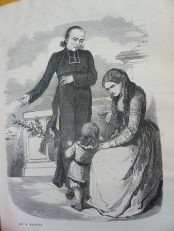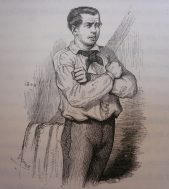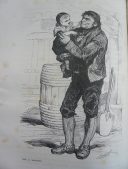
The Village Rector
LA COMEDIE HUMAINE – Honoré de Balzac XIIIe volume des œuvres complètes de H. DE BALZAC by Veuve André HOUSSIAUX, éditeur, Hébert et Cie, Successeurs, 7, rue Perronet, 7 – Paris (1877)
Scenes from country life

The village priest
THE VILLAGE RECTOR
Analysis It’s one of Balzac’s most moving novels, following on from Le Médecin de campagne in his Scènes de la vie de campagne. Le Curé de village, a project conceived in September 1838, was serialized in La Presse twice, in January 1839, then in July and August 1839, and was not published in bookshops until May 1841, after extensive reworking. Like Le Médecin de campagne, this is the story of a miracle that transforms the canton of Montégnac, on the borders of the Limousin and Corrèze regions. Like The Country Doctor, it’s also the story of reparation for a serious fault, redeemed by a lifetime of devotion: but this reparation is not that of a righteous man rehabilitating himself before his conscience, but a redemption before God. ” Le Curé de campagne,” says Balzac to Madame Hanska, “is the application of Catholic repentance to civilization as Le Médecin de campagne is the application of philanthropy, and the former is far more poetic and grander.” The secret of this tragic story is only revealed at the end. This chiaroscuro spread throughout the novel is one of its beauties today. We know, we come to know, that this novel tells the story of a woman’s crime, her repentance, her confession; and that this crime escaped the justice of men; that the priests guessed a lot, and that in the end, the peasant genius of Abbé Bonnet struck just the right blow against Veronique’s proud soul. With this obscurity, Balzac expressed his opinion, stating in a preface he added in 1841 to the first bookstore edition of Le Curé de village In the author’s plan, this book, far from offering the novelistic interest so avidly sought by readers, and which makes one turn briskly the in-octavo pages that one no longer rereads once the secret is known, seemed to him so uninteresting for public taste that it seemed necessary to enhance it with a dramatic conception, imbued with the character of truth, but in harmony with the tone of the work.” This rather awkward sentence is an admission of premeditated staging. As the “image of Catholic repentance”, Le Curé de village offered little novelistic interest, so it had to be spiced up with a dramatic presentation. “Until Véronique’s arrival in Montégnac, the events are obviously only the preliminaries of the real book. The main character is M. Bonnet, around whom the characters must gravitate, whereas in the book, as published, the curé plays only a secondary role.” Balzac then apologizes, declaring that his novel, as he would have wanted it, with Abbé Bonnet’s apologetic action in the foreground, would have become an impossible book to sell. He concluded with this consolation: “As for the work in its present state, it makes sense, the story is complete, and perhaps it will be found to be one of the most touching of those the author has invented.” There are two admissions in this preface. One recognizes that chiaroscuro is a dramatic subterfuge invented by the novelist to sustain interest. Indeed, the reader gradually guesses and suspects the truth, but only learns all about it at the dénouement, when Véronique makes her public confession: and even then, he or she has to read carefully to understand that Véronique approved of the idea of the theft, that she even followed the scene from a distance, and that she was terrified when she heard the screams announcing the murder. The other, more serious admission is that the book is incomplete in its meaning: “By what means,” Balzac objects, “did Curé Bonnet turn a bad, backward, unbelieving population, doomed to misdeeds and even crime, into a population animated by the best spirit, religious, progressive, excellent? That was certainly the book. This is indeed the objection that any thinking reader can make, along with Balzac. And Balzac even specifies, at this point in his preface, what he should have included in this indispensable fore-scene, which would have recounted the conversion of the inhabitants of Montégnac before showing Véronique’s reconversion. “For those who will notice this gap and sympathize with the long-meditated thoughts that dictated the Village priestthe author admits to having reserved (this was the original invention) a book whose plot takes place (or would have taken place) between the arrival of all the characters on stage (these are Véronique Graslin’s collaborators in the transformation of Montégnac) and Madame Graslin’s death.

Tascheron
This book contains (should have contained) the conversion to Catholicism of the Protestant engineer, the exposition of the doctrines of pure monarchy drawn from the eloquent things of life deep in the countryside, various episodes in which Curé Bonnet sees himself at work, which serve to explain the means employed by him to realize his evangelical project, and among which the author particularly regrets (it’s Balzac who then underlines) first communion in the village, catechism lessons with the parish priest, Christian Brothers classes, etc. Le Curé de villageif Balzac had been able to realize it according to this plan, would have been a didactic work, exactly the counterpart of Country Doctorinstead of the dramatic work we read. This picture book, inspired by the ideas of the great Catholic theorist Louis de Bonald, would have been a kind of counterpart to L’Emile by Jean-Jacques Rousseau. It would have been a complete and coherent presentation of Balzac’s political and religious ideas. It was not, however, this fundamental shortcoming that attracted the attention of Alain, a radical-socialist political theorist far removed from these concerns. It’s another gap that he points out, less serious, and probably deliberate, as it was necessary for the dramatic penumbra that Balzac had wanted. There remains in this novel,” he says, “a part that is unwritten, not even sketched out, and that we’ll never know: it’s the love story of Tascheron, a pottery worker, and Madame Graslin, wife of the richest banker in Limoges. The clues that remain, such as the fine shoes Tascheron is said to have worn on occasion, divert the imagination into some nocturnal alleyway where all will be lost. Another clue, alive but mute, is Véronique’s old mom, who only knew how to love and help her, and who obviously knew everything. But what? The course of this violent, murderous passion is known to us only through a few effects… The reader should note these and other things: what happens during the trial in Véronique’s salon, Mme Graslin, always full of friends, including the King’s prosecutor. There are rare signs, which the old mother, who is always on the lookout, immediately covers up. We don’t know any more; and in the end, we won’t know much more…” Gap or skill? All this contributes to the kind of spellbinding effect Balzac intended.

Véronique, expiatrice
This dramatic staging didn’t happen at first. Balzac’s prevarications have been brought to light by the study of surviving proofs and manuscript fragments. This study was the subject of Ki Wist’s work, published in Brussels between 1959 and 1964. The version published in La Presse’s first series of feuilletons is significantly different from the final version. The novel began with the story of Tascheron’s murder and execution. The first lines of the surviving manuscript of this serial show the bishop and his vicars contemplating the Vienne landscape from the terrace of the bishop’s palace, a scene that was carried much further in the final version. The story of the crime followed. This first part of the series seemed a complete story, as it ended with the final word. In this form, it was the story of an inexplicable crime. In the feuilletons published six months later, in July 1839, readers of La Presse learned the story of Véronique Graslin: a single word that escaped her at the end gave away the truth. This time, too, the novel appeared to be complete, as the final word was printed again after the last of these serials. Nevertheless, in a final series of feuilletons published from July 30 to August1, 1839, readers of La Presse could read about Véronique’s death, learn about the work she had accomplished at Montégnac, and finally learn the secret of events through her public confession. In this form, the serialized version was even more enigmatic than the final version. It already resembled what we now call a “detective story”, in which the culprit is only revealed at the end.

Sauviat, iron merchant
Many more additions were needed, particularly on the transformation of the arid lands of Montégnac, before we arrived at the version of Le Curé de village published in bookshops, which is the one we are reading today. Events from Balzac’s life, his trip to Bourg to try to save the notary Peytel, whom he had once known and who had been sentenced to death for murder, the rehearsals for a play by Balzac entitled Vautrin and its banning after the first performance, the publication of the short-lived Revue Parisiennethe judicial seizure of the house and land acquired at Les Jardies, near Sèvres, and finally the writing of several works to meet his commitments, explain the long delay of twenty-one months between the last serial of La Presse But Balzac’s extensive additions to the text of the feuilletons also played a major role. Even for readers who don’t know all this, The village priest is a singular work in several respects: firstly, because the country priest who gives the novel its title is neither the character in the foreground, nor even one who imposes himself on the reader’s memory with a few vigorous strokes: Balzac recognized him and explained why. But then, and for the same reason, because this novel of the countryside avoids describing the peasants. In the version we’re reading today, the entire first chapter, Veronique’s childhood and marriage, is an admirable “scene of provincial life”, not a “scene of country life”. Limoges, an old neighborhood, a century-old store where a scrap metal dealer from Auvergne, one of Balzac’s finest examples of a miser, piles up everything he’s been able to glean in fifteen years of revolutionary turmoil, an unknown and colossal fortune as a looter of wrecks. Inside, a pious, silent, secretive young girl, one of Balzac’s admirable, mute maidens, upset by a reading, married to a very rich, rather disgusting banker, who at thirty is a sort of queen of Limoges, beautiful, respected, solitary in this luxury that is foreign to her. It’s a lovely Balzacian departure, but without the peasants. These peasants are not in the picture, except for one convict who is not a Limousin farmer at all. What we see is a landowner and his major works. And this landowner, we realize with surprise, does not at all announce the fiery general who, in The PeasantsOn the contrary, a character analogous to that “handsome character of a great lord” that Balzac had wanted to paint in 1835 when he was thinking of another project, that of the Large Owner : and this benefactor, far from being obsessed with maintaining one of these latifundia The new government, which is useless and untouchable, thinks first and foremost of the well-being of its peasants, and doesn’t hesitate to organize the parcelling out of its territory to ensure general prosperity. It’s true that Véronique Graslin retains bare ownership: but in doing so, she behaves like a large capitalist landowner, not like the absolute master of a vast state forest. So what’s the solution to the latifundia problem? Do we count our wealth, as in Ukraine, by the number ofsouls to whom we dispense prosperity? Balzac’s opinion of peasants is no less embarrassing. They are represented in Le Curé de village by the solid, handsome Tascheron family, the very image of probity and honor. The last mass at the very hour when their son is tortured, the departure of the family, grouped around the two ancestors, leaving for exile like the Hebrews on the day of the Exodus – this gravity, this biblical simplicity is one of Balzac’s most moving pages. So, what are the peasants to think? Is it the Tascherons from Curé de village or the Tonsards depicted in Les Paysans ? Despite our research, which has given us a great deal of information on the writing of Le Curé de village, there still seem to be gaps in the information we’ve been able to gather. Works on the novel’s “sources” are limited to general indications. We only know that Balzac crossed the Limousin valleys he describes in his novel on the journey he made at the end of August 1832 from Angoulême to Aix-les-Bains, where he was to join the Marquise de Castries. He visited Limoges under the guidance of Philippe Nivet, Mme Carraud’s nephew. The route he then took towards Thiers and Clermont is the one taken in the novel by Abbé de Rastignac, secretary to the Bishop of Limoges, to fetch Abbé Bonnet from his mountain village. So far, however, we’ve been unable to identify the Montégnac site with any certainty, despite Balzac’s statement that it lies on the borders of the Haute-Vienne and Corrèze regions.
Source analysis: Preface from the 21st volume of La Comédie Humaine published by France Loisirs in 1987, based on the full text published under the auspices of the Société des Amis d’Honoré de Balzac, 45, rue de l’Abbé-Grégoire – 75006 Paris.
The Story In Limoges, the old Auvergne scrap merchant Sauviat and his wife have a daughter, Véronique, whom they raise as a perfect Christian. Silent, unknowingly passionate, Véronique marries the wealthy banker Graslin. She became the most perfect woman in Limoges, respected for her intelligence and virtue. No one but her mother knows that she has become the mistress of one of her father’s young workers, Tascheron, who loves her passionately. They both want to escape, to love each other in broad daylight. They’re thinking of a robbery at the expense of a lonely, hated old miser. The robbery goes wrong: the old miser and his servant are killed. Véronique saw nothing but understood everything. Discovered, Tascheron is condemned and tortured: but no one suspects the motive that transformed a gentle, honest young man, the youngest son of an irreproachable peasant family, into a murderer. Véronique conceals her tortures; she is expecting a child. Her son is born on the very day her young lover is tortured. Now the widow of old Graslin, Véronique is condemned to atone for the murder with which she was secretly associated. She settled in Montégnac, a miserable village where the Tascheron family lived. To make amends, she rehabilitated the arid slopes of Montégnac and ensured the prosperity of the poor peasants living in the village. She confides in Abbé Bonnet, a saint who himself transformed the inhabitants of this parish and accompanied young Tascheron to the foot of the scaffold. Under his leadership, she surrounded herself with the most enlightened helpers, built a dam, canalized the waters that were eating away at the soil, and turned a desolate region into a happy landscape. The reparation she offers in secret to the one she has loved is reparation before men, but not yet reparation before God. Her gaze fixed on the village grave of her young lover, whom she wanted to have in front of her, is, for the priest who directs her, a perseverance in sin. The pitiless penances she imposes on herself are not enough to erase the guilty destination of her works. She understands, thanks to Abbé Bonnet, that she is still a sinner through the form of her repentance, and that this repentance is only Christian if it is offered to God alone, in perfect repentance and oblivion of earthly passions. It is to this denouement that the gentle village apostle manages to lead her. She dies publicly confessing her complicity, tearing off the robe of virtue under which she had been revered, presenting herself as the sinner she is and yet to be forgiven. Paris, January 1837. – March 1845.
Source: Story summary taken from the preface to the 21st volume of La Comédie Humaine, published by France Loisirs in 1987, based on the full text published under the auspices of the Société des Amis d’Honoré de Balzac, 45, rue de l’Abbé-Grégoire – 75006 Paris.
The characters Abbé Bonnet: Parish priest in Montaignac, born in 1788. Abbé Bonnet has a sister and a brother, General Bonnet. General Bonnet: Brother of Abbé Bonnet, killed at Leipzig. Jérôme-Baptiste Sauviat: Limoges iron merchant, born in 1747, died in 1827. He marries Mlle Champagnac, daughter of Champagnac, a boilermaker in Limoge. Champagnac: Boilermaker in Limoge, father of Mlle Champagnac. Mlle Champagnac: Wife of Jérôme-Baptiste Sauviat. Pierre Graslin: (1775-1831), Limoges banker. He married Véronique Sauviat in 1823. Véronique Graslin: Born in 1802, she was the daughter of Jérôme-Baptiste Sauviat and Mlle Champagnac. Wife of Pierre Graslin. She died in 1844. Grégoire Gérard: Engineer in Montégnac, he later became mayor of the same town. In 1844, he married Denise Tascheron, sister of Jean-François. Tascheron: Montaignac family who, following their family’s misfortune (execution of Jean-François Tascheron), moved to America. The family still includes grandparents, parents, two daughters and 4 children. Jean-François Tascheron: born in 1806, Jean-François was a factory worker. He was executed in 1829 for theft and felony.
Character genealogy source: Félicien Marceau “Balzac et son monde” Gallimard.
No Comments